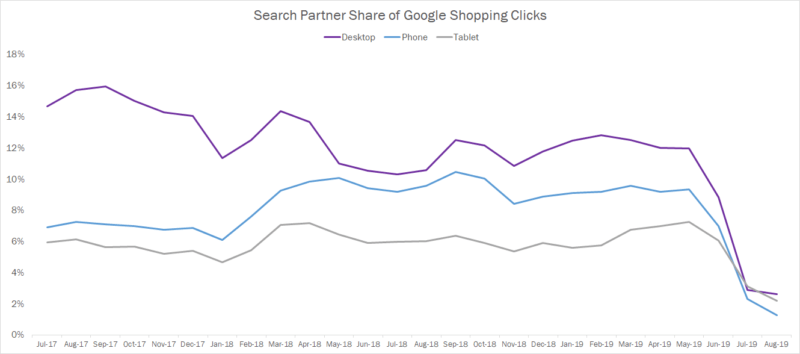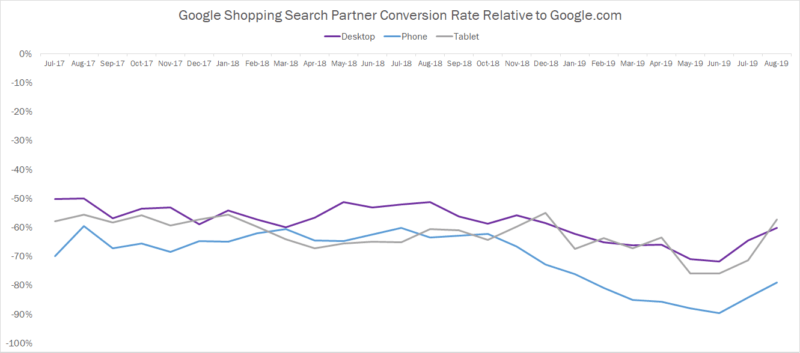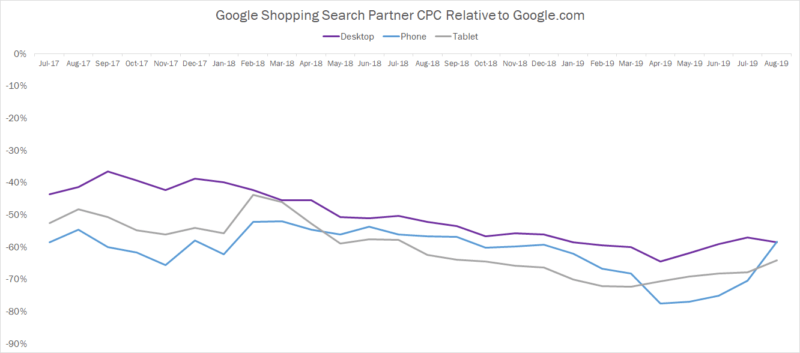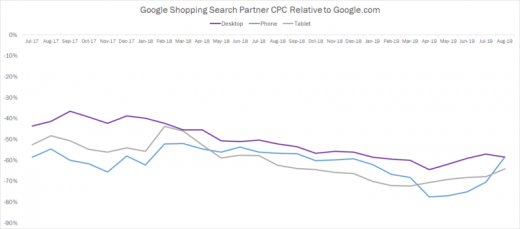With loss of Yahoo and image search, Google Shopping search partner traffic nosedives
While it is a small fraction of Shopping traffic, the partner network can help advertisers currently excluding this traffic to grow moving forward, particularly in a competitive Q4 holiday season.
Click traffic from the Google search partner network took two major blows in early 2019. The first was Yahoo’s move to begin showing only Microsoft Ads-powered sponsored listings following a more than a
Here we evaluate a sample of long-standing Tinuiti (my employer) advertisers to assess the effects of these changes to the share of Google Shopping traffic coming from search partners, the relative value and cost of that traffic, and what it all means for advertisers.
Search partner click share falls dramatically across device types
As you can see from the chart below, search partner traffic once accounted for a significant share of Google Shopping clicks, and in August 2017 was at 16% for desktop. In August 2019, that figure was just 3%, with share on tablets and phones at 2% and 1%, respectively.

The timing of the dip seems a bit delayed from what we might have expected given the details of the two announcements ostensibly driving this trend.
In the case of Yahoo, it announced in January that it would only serve Microsoft Ads, but the change was said to have rolled out through March. For image search, Google announced that it would be integrated into the core Search Network in late March. As such, April would have presumably been when much of the decrease occurred.
However, our numbers show that traffic share really took the biggest month-to-month dip from June to July. It’s not entirely clear why there seems to have been a delay, but the decline is certainly what we expected in light of these two changes, and it’s possible Google’s change to image search took longer than expected to roll out. There may have also been other less publicized updates to the partner network affecting these trends.
Some advertisers choose not to allow Shopping ads to show on the search partner network, owing to the lack of controls available in terms of bidding and where ads are shown. However, our research shows that the Google Search Partner Network is usually an efficient way to extend the reach of Shopping campaigns.
Search partner clicks convert at a lower rate than core search, but cost less too
Looking at the conversion rate of search partner traffic relative to core search, partners clearly convert at a significantly lower rate.

In July and August, search partner conversion rate improved relative to core search across device types. This makes sense if the image search change really did take a few months to roll out, since the transition of image search clicks from the partner network to core search would likely put downward pressure on core search conversion rate.
Regardless, the disparity in conversion rate might be enough to send some advertisers running to Shopping campaign settings to shut down the partner network. However, looking at relative CPC, search partner traffic also consistently tracks well below core search in the price paid for clicks as well.

All told, the median advertiser saw no difference in the cost per conversion of search partners versus core search network in August 2019. As such, opting Shopping campaigns into the partner network garners incremental traffic without harming ROI for many advertisers.
Conclusion
These updates meaningfully reduced the importance of the partner network to Google Shopping campaigns, and it seems unlikely that we should ever expect partner click share to regain its former heights. There just aren’t many properties out there for Google to partner with that can produce the kind of click volume that Yahoo and Google image search provide.
Still, it remains the case that the partner network is typically a worthwhile investment for retailers looking to maximize the reach of their Google Shopping campaigns. While it may only be a small fraction of Shopping traffic, it can certainly help advertisers that are currently excluding this traffic to grow moving forward. Particularly in the competitive Q4 holiday season, it would be a shame for brands to leave this opportunity on the table.
Of course, Google didn’t actually lose image search ad traffic, and those impressions and clicks are now just a part of its core Search Network. Advertisers that were already targeting the Search Partner Network shouldn’t have seen much of a change to overall Shopping traffic as a result of this update specifically, though the change may have forced competitors that were formerly excluding partners into competing for these image search placements.
Yahoo’s move did give Microsoft Ads traffic a boost, and while Google will likely continue to account for the vast majority of paid search traffic in the U.S., Microsoft Ads is still a crucial part of reaching searchers who might not turn to Google with their queries.
Opinions expressed in this article are those of the guest author and not necessarily Marketing Land. Staff authors are listed here.
Marketing Land – Internet Marketing News, Strategies & Tips
(25)



